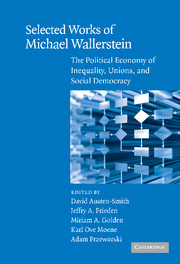 Selected Works of Michael Wallerstein
Selected Works of Michael Wallerstein Published online by Cambridge University Press: 27 January 2010
Introduction
Many scholars have observed that the politics of redistribution in the US is intertwined with the politics of race. Writing in the 1950s, Lipset and Bendix (1959) argued that the “social and economic cleavage” created by discrimination against blacks and Hispanics “diminishes the chances for the development of solidarity along class lines” (1959: 106). Myrdal (1960), Quadagno (1994) and, most recently, Gilens (1999) claim that racial animosity in the US is the single most important reason for the limited growth of welfare expenditures in the US relative to the nations of Western Europe. According to Quadagno (1994), political support for Johnson's War on Poverty was undermined by the racial conflicts that erupted over job training and housing programs. Alesina et al. (1999) find that localities in the US with high levels of racial fragmentation redistribute less and provide fewer public goods than localities that are racially homogeneous. Alesina and Glaeser (2004) conclude that racial conflict is one of the most important reasons for the low level of redistribution in the US compared to Europe.
The dominant approach in studies of race and redistributive politics in the US is to focus on the manner in which race affects voters' preferences regarding redistributive policies. Kinder and Sanders (1996) and Alesina and La Ferrara (2000) find that the sharpest contrast in preferences for redistributive policies in the US today is not between rich and poor or between men and women, but between whites and blacks.
To save this book to your Kindle, first ensure [email protected] is added to your Approved Personal Document E-mail List under your Personal Document Settings on the Manage Your Content and Devices page of your Amazon account. Then enter the ‘name’ part of your Kindle email address below. Find out more about saving to your Kindle.
Note you can select to save to either the @free.kindle.com or @kindle.com variations. ‘@free.kindle.com’ emails are free but can only be saved to your device when it is connected to wi-fi. ‘@kindle.com’ emails can be delivered even when you are not connected to wi-fi, but note that service fees apply.
Find out more about the Kindle Personal Document Service.
To save content items to your account, please confirm that you agree to abide by our usage policies. If this is the first time you use this feature, you will be asked to authorise Cambridge Core to connect with your account. Find out more about saving content to Dropbox.
To save content items to your account, please confirm that you agree to abide by our usage policies. If this is the first time you use this feature, you will be asked to authorise Cambridge Core to connect with your account. Find out more about saving content to Google Drive.